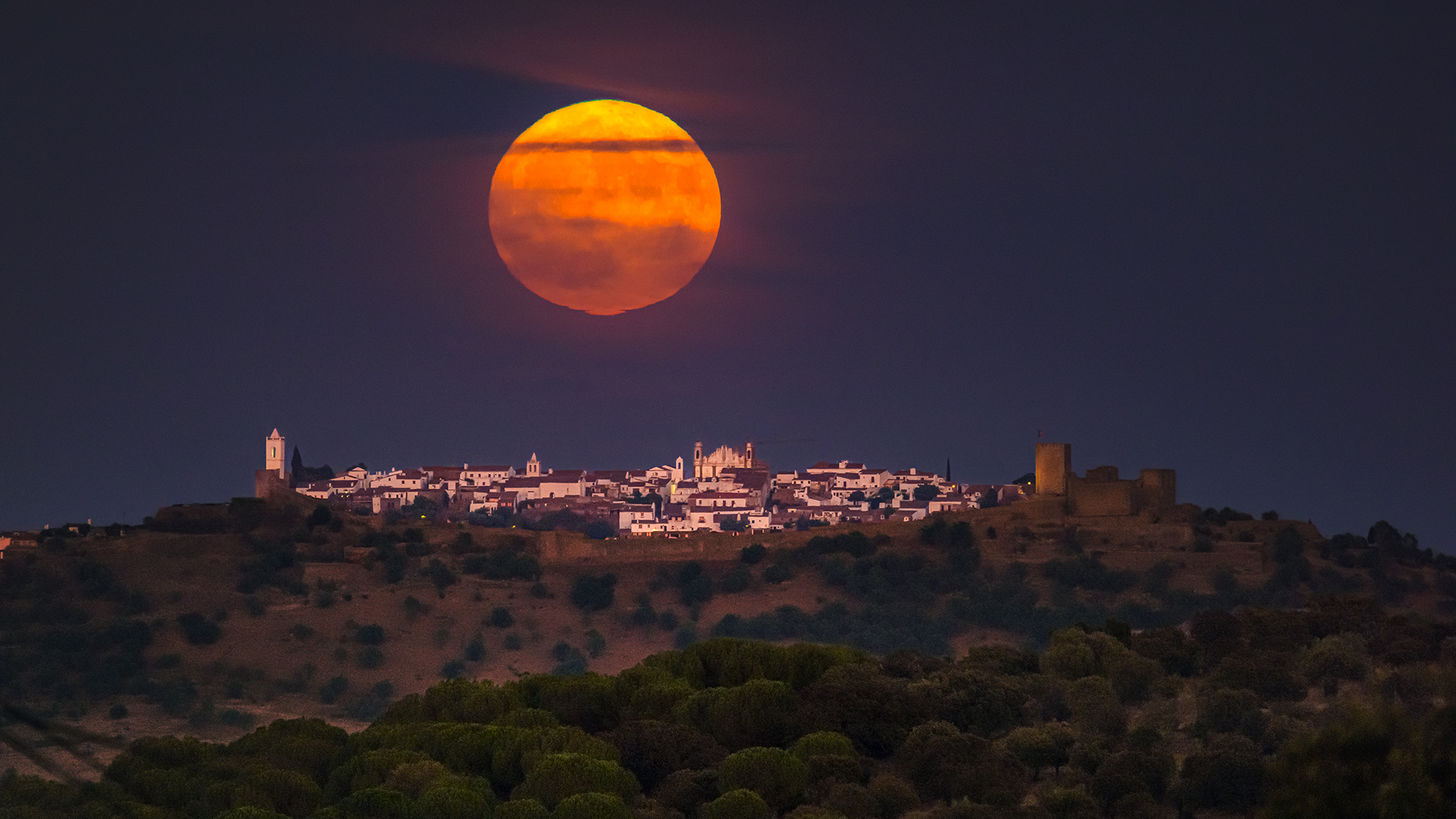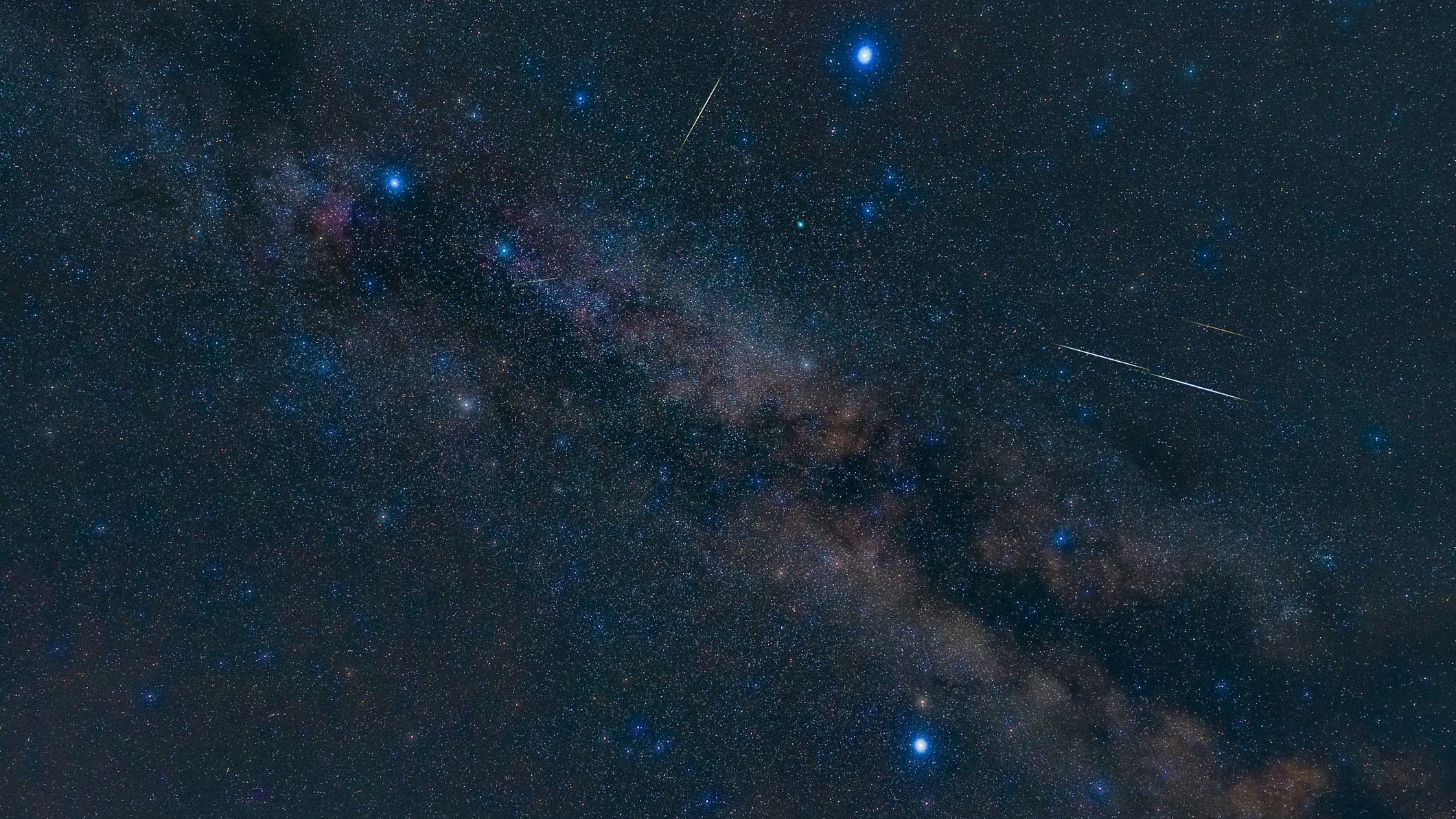October full moon 2024 guide: The Hunter's Moon is super
The Hunter's Moon officially becomes full on Oct. 17 at 7:26 a.m. EDT (1126 GMT).

The full moon of October, called the Hunter's Moon, will grace our skies on Oct. 17 at 7:26 a.m. EDT (1126 GMT), according to the U.S. Naval Observatory.
This full moon will also be a "supermoon," as it occurs a day after the moon reaches perigee, the point in its slightly elliptical orbit when it's closest to Earth.
When we see a full moon, it is on the opposite side of the Earth from the sun. In astronomical terms, the two bodies are separated by 180 degrees. This means that, from Earth, we see the moon fully illuminated, reflecting the sun's light. If one were standing on the moon somewhere near the center of its disk as seen from Earth, the sun would be directly overhead.
"Supermoon" isn't a true astronomical term; it's just a way of describing the moon when it appears slightly larger than normal because it is closer to Earth. The moon orbits Earth at an average distance of about 239,000 miles (384,600 kilometers), but the separation varies: At perigee, the moon is 225,740 miles (363,300 km) away, and at its farthest point (called apogee), it is 251,970 miles (405,500 km) from Earth. Supermoons happen when the full moon is close to perigee. During a supermoon, the moon appears about 10% larger than the average full moon, but unless one has been watching full moons very carefully for some time, it is difficult to see the difference.
Related: Supermoon: What is it and when is the next one?
The hour of lunar phases is determined by time zone, so the full moon might happen during the day or at night, depending on one's longitude. While on the Eastern Seaboard of the U.S. the full moon is in the morning, in Paris it is at 12:26 p.m., and in Melbourne, Australia, it is at 9:26 p.m.
In New York, the moon rises after it is officially full (it is below the horizon when the moment happens) at 6:13 p.m. and the sun sets at 6:12 p.m. With an unobstructed horizon in both east and west, it will be possible to watch the sunset and moonrise simultaneously from there. The full moon occurs after moonrise when one gets to points east of Yangon or Beijing; in the former, sunset is at 5:42 p.m. local time and the full moon is at 5:56 p.m. In Beijing, sunset is at 5:31 p.m. local time and the full moon is at 7:26 p.m.

Looking for a telescope to see the planets or the next skywatching event? We recommend the Celestron Astro Fi 102 as the top pick in our best beginner's telescope guide.
Visible planets in October
October's full moon will be joined by four of the naked-eye planets. Venus will be the first that becomes visible after sunset, though it will be difficult to see from mid-northern latitudes. From New York City, Venus sets at 7:44 p.m., only an hour and a half after sunset, and at sunset the planet is only 13 degrees above the horizon. Venus is bright enough that it is still visible even when the sky is still relatively light — look for it about 15 minutes after sunset — at 11 degrees high, one can just spot it, if the horizon is clear and has no obstructions. (Reminder: Your clenched fist held at arm's length covers about 10 degrees of sky.)
As one moves southward, spotting Venus becomes easier; from Miami, Venus sets at 8:44 p.m., and at sunset (6:51 p.m.) it is 21 degrees high in the west; the planet should become visible by about 7:20 p.m. and will still be about 15 degrees above the western horizon. It appears higher still as one gets to the tropics; from Honolulu, Hawaii, Venus sets at 8:02 p.m. local time on Oct. 17, nearly two hours after sunset (6:05 p.m.) — when the planet becomes visible at about 6:30 p.m. it is still 18 degrees high in the west.
From Singapore, which is only 1.3 degrees from the equator, Venus is at 30 degrees when the sun sets at 6:52 p.m. and does not set until 9:08 p.m. local time. In Cape Town, the sun sets at 6:39 p.m. and Venus is a full 38 degrees high; the planet sets there at 9:53 p.m.
The next planet to rise is Saturn, which in New York rises at 4:37 p.m. on Oct. 17, during the day. By moonrise the planet will be in the southeast, about 16 degrees high. The planet crosses the meridian (reaching its maximum altitude) at 10:10 p.m. Eastern time, when it will be just under halfway to the zenith at 40 degrees above the southern horizon. Saturn sets in the predawn hours at 3:42 a.m. (Oct. 18).
In more southerly latitudes, the ringed planet is higher; in San Juan, Puerto Rico, Saturn is 29 degrees high at sunset (6:00 p.m. local time), though the planet doesn't become visible until about 20 minutes later. It's in a similar position as in New York, in that it's still rising in the southeast as the moon gets above the horizon — moonrise is at 6:12 p.m. When the planet transits at 9:38 p.m., it is a full 63 degrees high.
In the Southern Hemisphere, the "reversal" of the sky means that Saturn appears over the northern horizon. Observers in Melbourne will see the planet 46 degrees high about 30 minutes after sunset (which is at 7:40 p.m. local time), with the moon rising in the northeast. In Melbourne, Saturn sets at 5:05 a.m. on Oct. 18.
Jupiter follows Saturn at 9:03 p.m. in New York, and the planet transits at 4:28 a.m. on Oct 18. The planet will be 71 degrees high with the moon to the right of it, high in the southwest. After that, Mars rises at 11:22 p.m. Eastern, and when Jupiter transits, the Red Planet will be 55 degrees high in the southeast.
From the Southern Hemisphere, Jupiter rises after midnight — in Melbourne, the planet rises at 12:12 a.m. local time on Oct. 18, and by about 2 a.m. Jupiter is 17 degrees high in the northeast, with the moon just west of north at 38 degrees high. Mars rises in Melbourne at 2:27 a.m., and by 3:30 the planet is 11 degrees high in the northeast, with the moon on the opposite side of the sky in the northwest.
October stars and constellations

In mid-northern latitudes — locations such as New York, Chicago, Sacramento or Madrid — by about 9:30 p.m. on Oct. 17, the Summer Triangle is still visible, but it is in the western half of the sky. The Summer Triangle is an asterism consisting of Deneb, Vega and Altair, the brightest stars in the constellation Cygnus the Swan, Lyra the Lyre, and Aquila the Eagle, respectively. Deneb is the highest of the three stars, with Vega below and to the right of Deneb. To the left of both and farther toward the horizon is Altair, the "eye" of the Eagle. Meanwhile, moving farther left (toward the south) one will see Fomalhaut, the alpha star in Piscis Austrinus, the Southern Fish. Fomalhaut will be below and to the right of Saturn.
One can look upward beyond the star Capella and see Perseus, which is a rough "Y" shape of stars with its brightest, called Algenib, at the crux of the Y. Looking up a little farther is the "W" of Cassiopeia, which one can use to find Polaris, the Pole Star, in Ursa Minor. While there are no "pointers" in Cassiopeia as there are in the Big Dipper, if one draws a rough line from the middle peak of the "W" to the left and downward, (at a near 45-degree angle between 9 p.m. and 10 p.m.), one will reach Polaris. The Big Dipper, meanwhile, will be close to the horizon, and will become more visible as the hours pass.
For Southern Hemisphere skywatchers, looking southeast at about 10 p.m. in Santiago, Chile, one will see Fomalhaut, to the right of Saturn at an altitude of 78 degrees; if one goes to the right and towards the horizon one sees Achernar, the alpha star of Eridanus the River, which winds across the sky all the way to near the feet of Orion. Below Eridanus, low in the southeast, will be Canopus, the brightest star in Carina, the Keel, hugging the horizon in the southeast. If one looks due south and turns to the right (toward the southwest), one can see Alpha Centauri, also known as Rigil Kentaurus.
Related: Constellations of the western zodiac
How the "Hunter's Moon" got its name

The October full moon is often called the Hunter's Moon, according to the Old Farmer's Almanac, because it happens when hunting for many game animals begins. (A lot of hunting seasons even now are set in the autumn months, though it varies by animal species.)
Hunting, though, isn't the only association with the October lunation. According to the Ontario Native Literacy Coalition, the Anishinaabe people called October's full moon the "Mskawji Giizis," or the Freezing Moon, because October is when the first frosts occur in their traditional territory in the Great Lakes region. For traditional Chinese calendars Oct. 17 is in the ninth lunar month, called Júyuè or Chrysanthemum Month, as it is when the flower of that name tends to bloom.
In Jewish tradition, the October full moon will be the start of Sukkot, a holiday lasting seven days commemorating the time when, according to the Torah, the Jewish people wandered the desert for 40 years after the escape from Egypt. Observant families will often build a sukkah, or temporary dwelling, to spend time in for that period.
The Maori of New Zealand had a lunar calendar that called the lunation from October to November Whiringa-a-rangi, and they called it one of the summer months, while the night of the full moon is called Rākau-nui.
Join our Space Forums to keep talking space on the latest missions, night sky and more! And if you have a news tip, correction or comment, let us know at: community@space.com.
Get the Space.com Newsletter
Breaking space news, the latest updates on rocket launches, skywatching events and more!

Jesse Emspak is a freelance journalist who has contributed to several publications, including Space.com, Scientific American, New Scientist, Smithsonian.com and Undark. He focuses on physics and cool technologies but has been known to write about the odder stories of human health and science as it relates to culture. Jesse has a Master of Arts from the University of California, Berkeley School of Journalism, and a Bachelor of Arts from the University of Rochester. Jesse spent years covering finance and cut his teeth at local newspapers, working local politics and police beats. Jesse likes to stay active and holds a fourth degree black belt in Karate, which just means he now knows how much he has to learn and the importance of good teaching.










